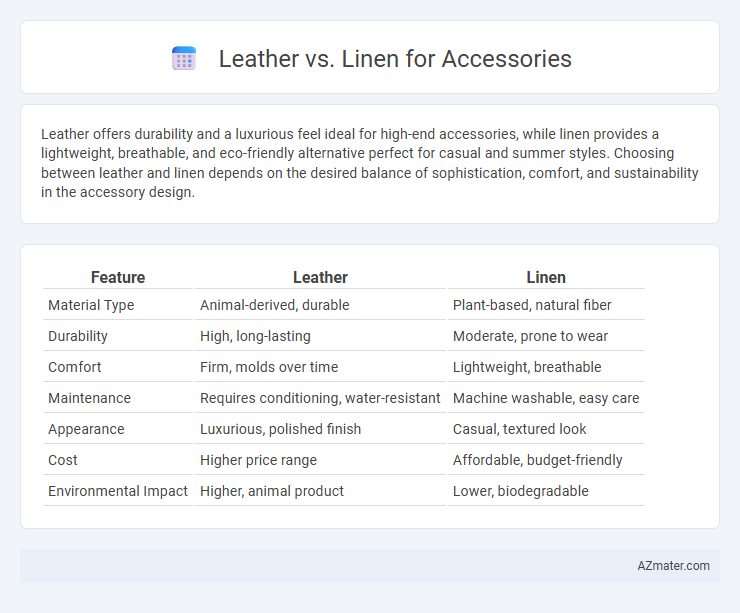Leather offers durability and a luxurious feel ideal for high-end accessories, while linen provides a lightweight, breathable, and eco-friendly alternative perfect for casual and summer styles. Choosing between leather and linen depends on the desired balance of sophistication, comfort, and sustainability in the accessory design.
Table of Comparison
| Feature | Leather | Linen |
|---|---|---|
| Material Type | Animal-derived, durable | Plant-based, natural fiber |
| Durability | High, long-lasting | Moderate, prone to wear |
| Comfort | Firm, molds over time | Lightweight, breathable |
| Maintenance | Requires conditioning, water-resistant | Machine washable, easy care |
| Appearance | Luxurious, polished finish | Casual, textured look |
| Cost | Higher price range | Affordable, budget-friendly |
| Environmental Impact | Higher, animal product | Lower, biodegradable |
Overview: Leather and Linen Accessories
Leather accessories offer durability, a luxurious texture, and natural water resistance, making them ideal for everyday use and high-end fashion. Linen accessories provide lightweight breathability, eco-friendliness, and a casual, textured appearance suitable for warm climates and sustainable style. Both materials serve unique aesthetic and functional purposes, with leather excelling in longevity and linen in comfort and sustainability.
Material Composition: Leather vs Linen
Leather, derived from animal hides primarily composed of collagen fibers, offers durability, flexibility, and water resistance, making it ideal for long-lasting accessories. Linen, made from flax fibers, features a lightweight, breathable, and natural texture, providing comfort and eco-friendly qualities but less resistance to wear and moisture. Choosing between leather and linen for accessories depends on desired strength, aesthetic, and maintenance preferences, with leather excelling in toughness and linen favored for its sustainability and softness.
Durability and Longevity Comparison
Leather exhibits superior durability and longevity compared to linen, as its natural toughness resists wear, scratches, and moisture over extended periods. High-quality leather accessories typically develop a unique patina, enhancing aesthetic appeal while maintaining structural integrity for years. In contrast, linen is more prone to fraying, staining, and degradation, making it less suitable for long-lasting accessory use.
Comfort and Wearability Factors
Leather accessories offer durability and a smooth, flexible feel that molds to the skin over time, enhancing comfort with regular use. Linen accessories provide a lightweight, breathable alternative that reduces moisture buildup and prevents overheating, ideal for warmer climates. The choice between leather and linen hinges on balancing long-term wearability with temperature regulation and personal skin sensitivity.
Style and Aesthetic Appeal
Leather offers a timeless, luxurious aesthetic with its smooth texture and rich tones, making accessories like belts, bags, and wallets appear sophisticated and durable. Linen provides a lighter, natural look characterized by its breathable fabric and subtle texture, ideal for a casual, earthy style that complements warm-weather outfits. Choosing between leather and linen accessories depends on the desired style impact: leather conveys elegance and strength, while linen emphasizes freshness and relaxed charm.
Maintenance and Care Requirements
Leather accessories require regular conditioning with specialized leather care products to prevent drying and cracking, and they should be kept away from excessive moisture to maintain their durability and appearance. Linen accessories demand gentle washing, often hand-washing or machine washing on a delicate cycle, and air drying to avoid shrinking and damage to the fabric's natural fibers. Both materials benefit from storage in cool, dry places to extend their lifespan and preserve texture and color.
Cost and Value Analysis
Leather accessories generally have a higher upfront cost due to the material's durability and premium quality, offering long-term value through extended wear and aging gracefully over time. Linen accessories tend to be more affordable initially but may require more frequent replacement due to lower durability and susceptibility to wear and stains. When considering cost and value, leather provides a superior investment for accessories needing longevity, while linen suits budget-conscious consumers seeking lightweight, breathable options.
Environmental Impact and Sustainability
Leather production generates significant environmental impact due to high water usage, deforestation, and greenhouse gas emissions from livestock farming, while its biodegradability is limited by tanning chemicals. Linen, derived from flax plants, offers a sustainable alternative with low water and pesticide requirements, and it is biodegradable, making it environmentally friendly for accessory production. Choosing linen over leather reduces carbon footprint and chemical pollution, supporting sustainable fashion initiatives.
Popular Accessories: Leather vs Linen Choices
Leather dominates popular accessory markets with durable items such as wallets, belts, and handbags, prized for their luxurious texture and longevity. Linen, favored for lightweight scarves, hats, and tote bags, offers breathability and eco-friendly appeal, making it ideal for casual summer wear. Choosing between leather and linen depends on desired durability, texture, and seasonal use, with leather excelling in classic, long-lasting accessories and linen preferred for breathable, sustainable options.
Which Material Suits Your Lifestyle?
Leather offers durability, water resistance, and a classic, sophisticated look ideal for active lifestyles and professional settings. Linen provides breathability, lightweight comfort, and a natural, casual aesthetic perfect for warm climates and relaxed environments. Choose leather for long-lasting accessories that endure wear and tear, while linen suits those prioritizing eco-friendliness and easy maintenance.

Infographic: Leather vs Linen for Accessory
 azmater.com
azmater.com